Menus
- Aprilia challenges KTM, BMW and Yamaha
- KTM 1290 Super Duke R.
- BWM S 1000 R
- Yamaha MT-10 SP
- Aprilia Tuono v4 1100 Factory
- MOTORCYCLE test result
- survey
- Conclusion
Theme special
Everything about BMW Motorrad
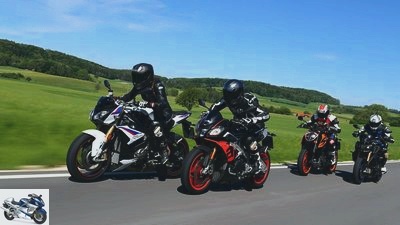
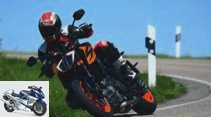
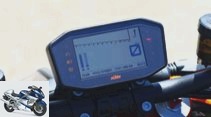
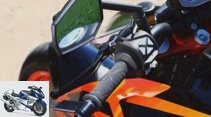
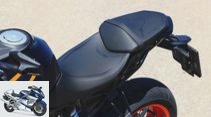
29 photos

1/29
In a comparison test, the BMW S 1000 R, KTM 1290 Super Duke R, Yamaha MT-10 SP and Aprilia Tuono V4 1100 meet? Which bike will win the test? It all starts with the power naked bike from KTM.
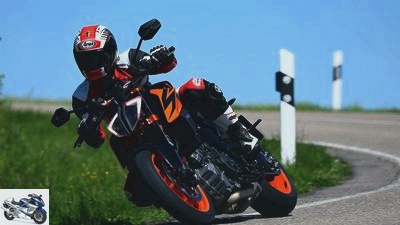
2/29
Driving Super Duke is still an entertaining cannonball ride despite immense pacification measures.
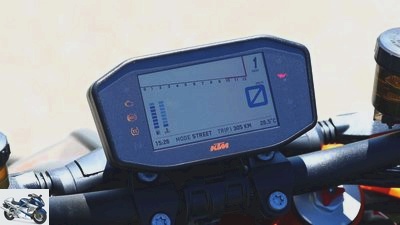
3/29
State of the art, but capricious fuel gauge and only roughly readable tachometer.
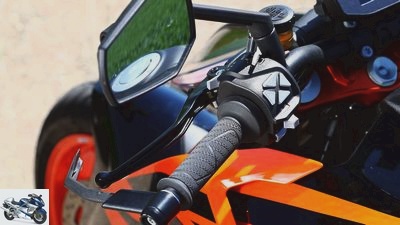
4/29
Four separate buttons instead of a joystick for electronics adjustment. Works well.
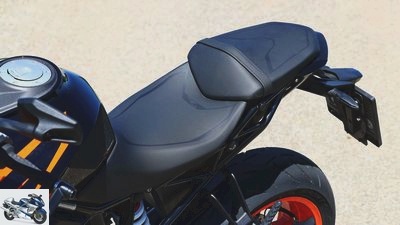
5/29
A cozy place for two. Unfortunately a bit slippery, which can be nice for two.
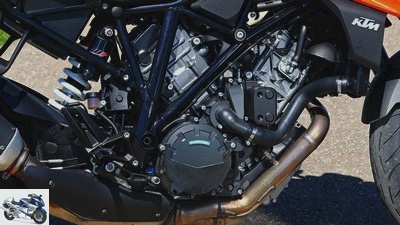
6/29
Hence “The Beast”: 1301 cubic meters, almost 180 hp and truckloads of torque. Is strongly trimmed to mobile through translation and electronics.
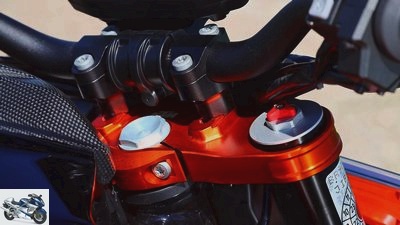
7/29
Old school: Here the chassis is still adjusted manually. Nice, but not cheap: CNC-milled triple clamp set from the Power Parts range.

8/29
“Engine, design, sound: a real men’s motorcycle. But the chassis needs fine tuning “
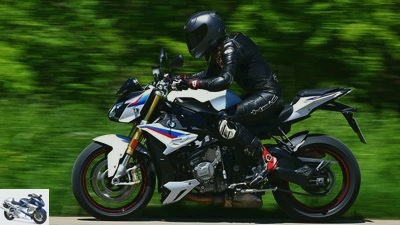
9/29
BMW with its “old-school four-wheeler” and the flawless function is almost a bit boring. Even the laboriously programmed aggression does little to change that. Until you pull the gas. Still a gun.

10/29
Pushes, pulls, tears, screeches: there is hardly a better way to make a four in a row.
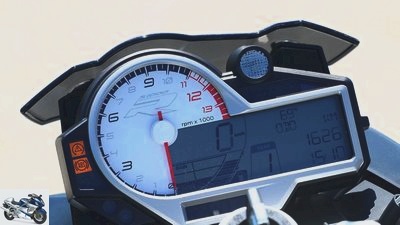
11/29
Basically easy to read, but the LCD optics are “outdated” in this price range.
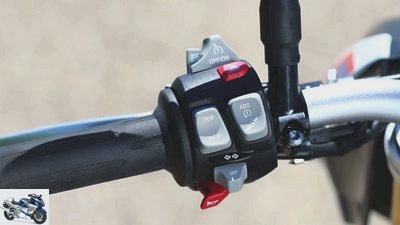
12/29
Not quite as much electronics, not quite as many switches. Has advantages too.
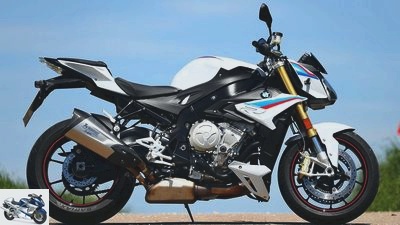
13/29
“Comfortable, sporty, easy to handle, but also a little unspectacular. The BMW is simply good! “
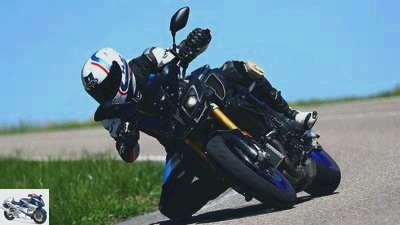
14/29
Hats off, no other Japanese currently dares to go into this performance and status class. A sovereign, by Japanese standards almost unreasonable offer with a unique engine concept. Nothing for lap time fanatics or food lover, everything for sporty connoisseurs.
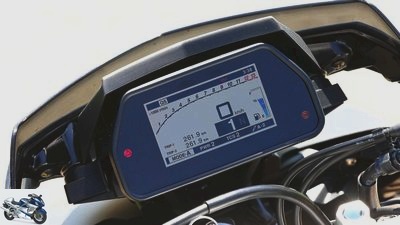
15/29
All E parameters can be adjusted “on the fly”. Warning: fuel gauge is lagging behind.
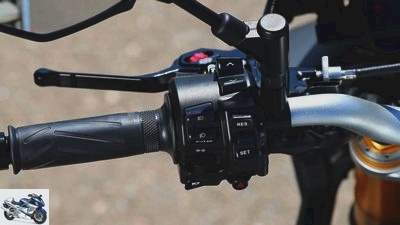
16/29
Not nice, but functional: rough fittings, on the right there is also a setting wheel.
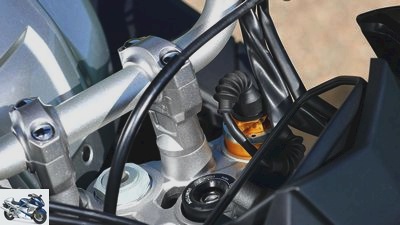
17/29
These risers have earned their name, the handlebars are very high.
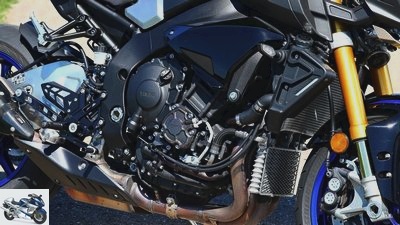
18/29
Rossi feeling included: characteristically roaring, fine-nerved and easy-drinking row quad with 90 degree crank pin offset.

19/29
The polished swing arm with chain feedthrough is almost Italian. Also chic: accessory ratchet system from Gilles Tooling.
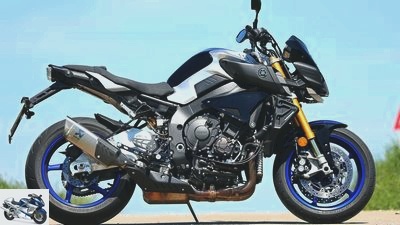
20/29
“The MT drives absolutely confidently and hangs really well on the gas”.
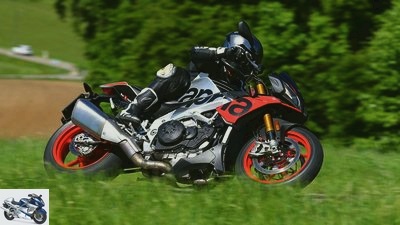
21/29
If there is nowhere more power than on the KTM, there is nowhere more hard performance than on the Tuono. And nowhere more sensuality. You can’t get any closer to the superbike. The electric chassis works superbly, but is complex to use.
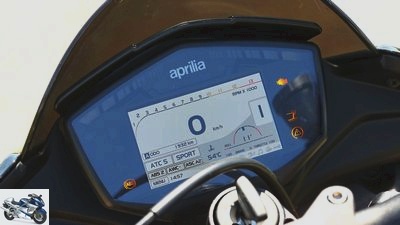
22/29
Nicely done color display, on which the information clumps up rather badly.

23/29
Excellent: the metal rockers for the TC. It works like this: the joystick for almost everything else.
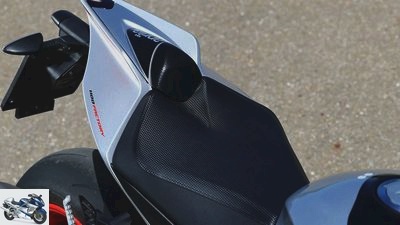
24/29
Yes, you can exchange this wing for a seat roll. No, you don’t want that.

25/29
So much power, emotion and smoothness can rarely be found in the same engine. You pay the price for this first at the dealer, then at the gas station, where you spend a lot of time.
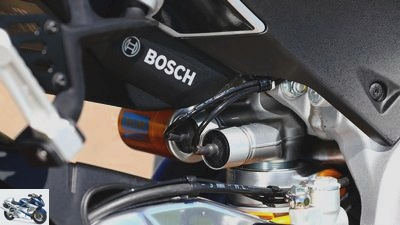
26/29
Screwdrivers were yesterday: fully adjustable Ohlins TTX shock absorber. In general, the Aprilia offers a wealth of options for chassis adjustment.
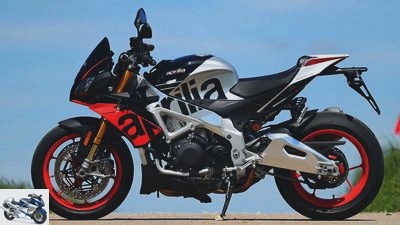
27/29
“Motor, brakes, chassis, electronics and amore: nothing more is possible than on the Tuono”

28/29
Not a sip of water in the curve: Anyone who wants to bend around the radius with maximum experience is more than well advised with each of these four KRAFT wheels.
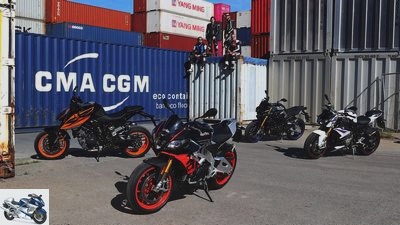
29/29
As soon as you are at the top, you can of course always ask the question: Wouldn’t five million instead of ten million be enough for the DAX board of directors? Does a luxury sedan really have to weigh 2.5 tons? And who actually needs naked bikes with a top speed of 280 km / h? Yes, no and no one would like to shout out reason as answers.
Power naked bikes in a comparison test
Aprilia challenges KTM, BMW and Yamaha
The new Aprilia Tuono V4 1100 Factory with electronic chassis meets proven competition: BMW S 1000 R, KTM 1290 Super Duke R, Yamaha MT-10 SP. Which naked bike of the 2019 model year wins the comparison test?
To begin with, a small, only minimally adapted quote from MOTORRAD Kapo Michael Pfeiffer: "For a long time no one has noticed whether you have five hp more or less, whether it’s 175, 180 or even 185 hp. And on public roads the driver is always too fast anyway. […] And with 15,000 euros, the pain threshold is reached for many." Words that, in view of the illustrious test field of power naked bikes that we have collected for this story, do not seem out of thin air. And that, even though they didn’t even begin with the naked grenades from Aprilia, BMW, KTM and Yamaha are written in the head. None of them existed at the time. Back then, that was almost exactly ten years ago, and instead of the current naked bike elite, the supersport pack of that time was buzzing around in the head of the boss in the editorial of issue 6/2009. So why take a look at the past? Because often only then do we notice where we are currently and how fast the unstoppable wheel of development continues to turn.
Buy complete article
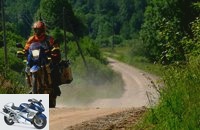
Comparison test of power-naked bikes
The fanatical four
Electronics packages make the difference
The most powerful naked bikes have long since reached or even surpassed the performance level of sports motorcycles that were not that old. And for that "shocking" 15,000 Euro fee from the quote, none of the naked stars can be motivated to appear, at most the BMW, if you order them naked not only in terms of disguise, but also in terms of equipment. A more than rare case in the house of the blue and white. "So why not just buy a well-hung R1, RC8 or 1098 from back then and set aside thousands of euros for gasoline, accessories and a few scoops of ice cream for the stopover?", one might ask. Firstly, because no youngtimer athlete, no matter how good, offers his undoubtedly fierce dynamic promise as user-friendly as the Tuono, S 1000 R, Super Duke and MT-10 SP.
Four bikes, one winner – which naked bike will win the comparison test?
This is due both to the significantly more human-friendly ergonomics and – and this is where the real progress – lies in a comprehensive package of electronics that the athletes of yore could only dream of. Second, because today it is no longer just a row fours or V2. And third, because then, as now and tomorrow, it’s just great to have the latest shit, to put it bluntly. And this is currently called Aprilia Tuono V4 1100 Factory, the most impressive contribution to the Landstrabenfeger case, not just since yesterday. But since today it has been enriched with an electronically controlled chassis. Immediately behind it, the KTM 1290 Super Duke R, which has also recently been finely honed, is pushing for the successor to the throne qua absurdly strong V-twin. Japan’s only member of the bare 160-PS-Plus-Club, the Yamaha MT-10 SP, holds against it with angry crossplane tubes and the finest e-goods from Ohlins. And Germany? Do what it does best and send the BMW S 1000 R not exactly the latest, but perfectly developed four-pot screamer into the race. Let’s see if something can be found that can be cited for 2029.
KTM 1290 Super Duke R.
That must have hurt in Bologna. The twin quake, which had been the undisputed epicenter for decades, relocated to Mattighofen in 2014. Nobody had put a more powerful V2 in so little motorcycle before. And even today, the Super Duke experience is largely fed by the raw power that the ultra-modern 1301 cubic centimeters, distributed over just two cylinders, produce. To be precise: certified 177 hp and 140 Newton meters, both at comparatively moderate speeds. So much power that the ride on the Austrian Duke still has a lot of the same on a cannonball despite continuous domestication. Sure, the Monster V2 has a difficult position against the various four-cylinder concepts in terms of running smoothness due to its design, but the Super Duke impressively shows the consequences of an absurdly large and absurdly powerful twin in an absurdly compact motorcycle even without this handicap in mind brings with it.
Driving Super Duke is still an entertaining cannonball ride despite immense pacification measures.
The KTM has an absurdly long translation, which makes the deep speed valley of chopping and whipping larger rather than smaller. Under 3,000 to 4,000 revolutions there is already a lot of power, but there is hardly any concentricity. Snorkeling through the city in fourth gear, normal on four-cylinder, is at best a pious wish. In spite of the noticeably defensive translation between the throttle grip and the throttle valve opening as well as the visibly tried traction control, it pulls so on the other side that it’s all over. Fully loaded is an even greater test of courage here than with the remaining combatants who are also really strong. That is impressive and still entertaining even after several years of motorcycle testing. Hard to imagine how the beast would drive without all this taming. Although, if you can loose 341 euros for the track pack, you get an idea. Then the strict traction control can be loosened up to the point of inactivity, the wheelie suppression switched off and the very smooth throttle response adjusted to digital response. Those who cannot realistically assess their abilities now should "take all necessary precautions" have already met.
The engine of the Super Duke has an output of almost 180 hp.
Either way, a rough fellow. What also goes well with the transmission and chassis. With or without an automatic switch: You need lard in the toe. The completely analog White Power Hardware by no means does a bad job, but in this elitist society it lacks stability and precision. The Duke needs a leading hand when it comes to cornering. The last bit of feedback is missing, a reproach that is usually made with the e-chassis. Even when you are inclined, there is often a little more movement in the load than you wanted. In return for all the necessary firmness, there is a decent amount of residual comfort and responsiveness, but the directly hinged shock absorber directs short road irritations very emotionally into the back chain. A contemporary redirection including a more humane spring rate could work wonders here. And otherwise? The Austrian scores where you can from "The Beast" not necessarily expected: in everyday life. You sit almost as upright as on a supermoto, only with a properly padded bench, and you can even invite passengers with a reasonably clear conscience. Thanks to the LED headlights, nights become day, dangerous situations become trivial thanks to powerful and sensitive anchors. And who would have thought: Apart from the wear on the rear tires, the beast is comparatively frugal. Victory on points.
BWM S 1000 R
Pomm PrroPomm Propp." Every time you take your foot off the gas. Always exactly the same, never subtle and always as a result of veritable screeching. The fact that a BMW is way ahead in the riot rating is still surprising despite the constant brand dynamism. Wherever you look, hear or feel, there is only one direction for this Wuterich from Munich: forward, and fast. Shaped like a wedge from rear to front, always roaring, grinding and scraping and then this power. Conventional in-line quad, comparatively small displacement, not exactly the latest. No matter who sows wind on the throttle, reaps storm on the rear wheel. Except for the even angrier Aprilia, this stable, vibrating screamer runs everything down. And still proves that Bayern still have a heart for the real world. No one accelerates more gently – regardless of the driving mode – no one lets the gears intermesh more smoothly, be it conventionally or with an automatic gearshift, and none is cheaper. You read that correctly, even with the usual full equipment, this BMW is the cheapest offer in the high-priced test field – albeit scarcely.
BMW with its “old-school four-wheeler” and the flawless function is almost a bit boring.
On the other hand, you are not fully up to date electronically, but you are also not without a chance. The lack of modern light and a fancy TFT cockpit as well as only two settings for the semi-active chassis only hurt at the regulars’ table. The conventional Quasimodo headlights do their job significantly better than, for example, the LED cyclops eye of the Yamaha. The analog tachometer is easier to read than any digital counterpart. And the chassis stifles any accusation of two-dimensionality with sovereign function: sticks cheekily into the corner, is outstandingly mobile, nevertheless remains stable at all times and caresses troubled midlife backs as best as class and positioning allow. There can be the appropriate attitude "Road" stay in 90 percent of the time. "Dynamic" Then it is suitable for everyone who is serious, who is far from midlife or who would like to count bumps.
A little less frills, but still a weapon: BMW R 1000 S.
Speaking of counting: It’s quick when it comes to weaknesses. The clutch lever sticks out uncomfortably. Which wouldn’t be a problem if it were adjustable according to time and price class – which, by the way, the Aprilia can’t do either. And the previously almost unyielding bite of the front brake was sent to nirvana in Munich with the last little update in 2017, along with fine controllability. Otherwise there is little functionally speaking against the BMW, see rating. But the same applies to Angela Merkel, who – I lean out of the window now – should rarely be the object of wet dreams. And there lies perhaps the biggest, albeit superficial, crux of the Bajuwarin: Really sexy is different now.
Yamaha MT-10 SP
My hopes were high when Yamaha finally put its famous crossplane – ergo ignition offset – ergo pseudo V4 drive from the R1 in a bare environment in 2016 and inherited the long-grayed FZ1. Could it be a kind of budget Tuono, with Japanese solidity and Japanese pricing? Not even close. Don’t be fooled by the impressive performance data, the martial appearance and the beguiling sound: the MT-10 is neither a stripped super athlete nor the ultimate straightening device for the road. Gentleman’s choice for the brisk and, if necessary, very brisk country trip is more likely. Even the desirous SP specification does not fundamentally change this
A sovereign, by Japanese standards almost unreasonable offer with a unique engine concept.
The very first seat test is evidence of this. It feels like you are standing on this like almost any MT, at most you are placed within calling distance of the front wheel. This allows you to look forward to high daily kilometers in a relaxed manner, but noticeably dilutes what constantly wanders up over the fork to the handlebar ends. The semi-active Ohlins gold also has its share in this. But that is its only disadvantage. It is rare to see how gently these high-tech parts caress themselves over any asphalt. Responsiveness and driving comfort have no opponents to fear in this environment. To do this, the transformer turns in so easily, nestles itself so neutrally from one inclined position to the next and lies so full of confidence that one can generously ignore the lack of the last bit of transparency. Great job. The less hard of the two automatic modes ("A2") actually always fits, if you don’t have to chase a Tuono that has gone wild. Like the two semi-active modes, the three conventionally damping setups M1 to M3 can be manipulated extensively, but lose a bit of the much-invoked smoothness in comparison. With the committed Hatz, the limit is not set by the chassis, but by the lack of maneuverability. The MT clearly needs the most strength when things have to be done quickly.
How does the only bike from Asia compare to the European competition?
Which is not a problem for the engine. This is a really big combustion cinema. You can almost enjoy the running culture that is typical of a row of four, including the earliest concentricity and huge usable speed range, but without having to forego V4-like tubes. At the bottom he packs "CP4" still a bit undecided to shoot forward wildly from 4,500 rpm. Including fine throttle response (recommendation: "PWR 2"), exclusive vibrations. Broop, Broop, Broop: If you then use the Quickshifter (the only one without a downshift function) to tear through the gears in the somewhat power-consuming gearbox, you get that real GP feeling. However, this quickly goes away as soon as speed has to be reduced. Minimal lever travel, glassy pressure point: The brake metering is not a highlight, which is certainly not entirely due to the built-in accessory lever. So top tip: original levers. Then you have a little more money left over for gasoline. And the Yamaha needs almost as much of it as the Aprilia. I said yes: this is not a budget Tuono. And that’s good.
Aprilia Tuono v4 1100 Factory
When it comes to the naked thunder from Noale, I always tell the same simple anecdote: I’ve been doing the job for almost five years and can’t count, let alone recap, how many motorcycles I’ve ridden since then. But when I am asked which one was the best, the craziest or the most impressive for me personally, the answer is always: Tuono 1100. Regardless of whether factory or standard, Euro 3 or Euro 4. This motorcycle has an emotional impact, coupled with the most violent high End function that is difficult to put into words despite repeated attempts. The constants are the unbelievably sounding and tearing motor, the unbelievably sensitive electronics and the unbelievably sharp handling. The former was not touched for the 2019 model year, so it left a few feathers for the Euro 4 update, both in terms of sound and penetration. However, that’s about as if Arnold Schwarzenegger was considered a weakling at his sporting zenith, because instead of 120 he weighs only 117 kilos. It is still enough to sprint the entire test field against the wall. The performance does not come like a raid like the KTM, is much easier to tap thanks to a suitable gear ratio and much better running smoothness and fine throttle response.
If there is nowhere more power than on the KTM, there is nowhere more hard performance than on the Tuono.
So far, so well known. There is something new in electronics. And in terms of handling, at the same time: this year the Tuono Factory was supplemented by a semi-active chassis. The "Aprilia Suspension Control" (ASC) relies on the finest Ohlins goods, NIX fork on the front, TTX damper on the rear. As expected, the system works great. And as expected, the service is disastrous. First: the joystick provided for this is hypersensitive. Second: Adjustment is not possible while driving. Third: It takes time to understand the operating logic. While the three conventional suspension modes work with 31 electronically adjustable clicks for compression and rebound (21 for the steering damper!), At first glance the three semi-active modes are supposedly all set the same. Instead of compression and rebound, the hardness and braking assistance can be set in five plus and minus steps. In the sportiest semi-active mode "A1" can still "Acceleration"- and "Steering assistance" (not to be confused with the setting of the steering damper). A real playground for setup tinkerers.
The Aprilia scores with a good electronics package.
All others put the automatic mode "A3" one that the Tuono with corresponding withdrawal of the point "hardness" more comfortable than ever. It’s still so tight and athletic that it is enough for most life-affirming applications. At "A2" the knife should already linger between the teeth, "A1" better suited for the racetrack. Here, too, the semi-active modes provide a slightly finer response than the conventional ones. In any case, the ASC delivers a level of transparency and precision that has never before been seen on a non-super sports car with an electric chassis. You don’t notice that it is there, which is known to be the highest praise for the whole electric vodoo on two-wheelers. In addition, the Tuono is as stable and lean as only a Tuono can without sacrificing mobility, like the MT-10. Criticisms? Yes, 19,992 pieces. 19,990 of these are attributable to the purchase price. Where an adjustable clutch lever would be really appropriate. And with so many manipulation options, the spring preload could have been digitized right away, for example on the good old BMW. Anyway, my answer remains the same: Aprilia Tuono 1100.
MOTORCYCLE test result
1st place: KTM 1290 Super Duke R (713 points out of a possible 1000)
2nd place: BMW S 1000 R (707 points out of a possible 1000)
3rd place: Aprilia Tuono V4 1100 Factory (688 points out of a possible 1000)
4th place: Yamaha MT-10 SP (675 points out of a possible 1000)
survey
Which of the four tested power naked bikes of the 2019 model year is your favorite?
Voted 974 times

Aprilia Tuono V4 1100 Factory.

BMW S 1000 R..

KTM 1290 Super Duke R..

Yamaha MT-10 SP.
read more
Conclusion
As soon as you are at the top, you can of course always ask the question: Wouldn’t five million instead of ten million be enough for the DAX board of directors? Does a luxury sedan really have to weigh 2.5 tons? And who actually needs naked bikes with a top speed of 280 km / h? Yes, no and no one would like to shout out reason as answers. And yet the boundaries of reason are constantly shifting, as the look into the past made at the beginning shows. What was considered a superlative yesterday can be quite normal today. Perhaps in ten years we will be amazed how a power naked bike can seriously compete with less than 200 hp and a top speed of 300 km / h. Everyone has to know how they feel about it. It is undisputed that playing with the spearhead of undisguised motorcycles is a fascinating one. And that you can’t make a bad buy in the current 160 hp class. Whether you are looking for excessive power (KTM), laboratory-like perfection (BMW), performance suitable for the racetrack (Aprilia) or fine-nerved sovereignty (Yamaha): Nobody has to go out empty, provided that their wallet isn’t exactly: empty. But who knows, maybe in ten years someone will ask at this point: "Why not just buy a well-hung Super Duke, S1000 R, Tuono or MT-10?"
Related articles
-
fact 44 pictures fact 1/44 Aprilia Tuono V4 1100 Factory, BMW S 1000 R, Ducati Monster 1200 R, Honda CB 1000 R, KTM 1290 Super Duke R, Triumph Speed Triple …
-
Comparison test of 125cc naked bikes – Aprilia Tuono 125, Yamaha MT-125 and KTM 125 Duke
18 pictures 1/18 Away with the smartphone, boys and girls. Forget Twit-Snap and Insta-Chat, because real life takes place outside …
-
Nine power naked bikes in a comparison test
fact 57 pictures fact 1/57 Simple, good: excellent readable instrument cluster with analog tachometer and the most important digital. fact 2/57 The …
-
Power Naked Bikes in Comparison – Part 2
31 photos 1/31 BMW S 1000 R, Honda CB 1000 R, Kawasaki Z 1000, Suzuki GSX S 1000 and Yamaha MT 10 in the comparison test….
-
Concept comparison of super athletes and naked bikes from BMW, Yamaha and Aprilia
www.factstudio.de 39 pictures factstudio.de 1/39 The big concept comparison: three super athletes compete against their naked bike derivatives. markus-jahn.com …
-
Alpen Masters 2017 Power Naked Bikes in the test
Photo: fact 16 photos fact 1/16 Power Nakeds at the 2017 Alpine Masters: Yamaha MT-10 SP, Aprilia Tuono V4 1100 RR, Ducati Monster 1200 S and KTM 1290 Super …
-
7 power naked bikes in a comparison test
Gargolov 54 pictures Gargolov 1/54 Power-Naked-Bikes. That sounds like purism, like motorcycles that don’t have more than necessary. Gargolov 2/54 The …
-
A comparison test of dream bikes from the PS editors
Markus Jahn 22 pictures markus-jahn.com 1/22 Two power nakeds and two superbikes form a powerful force. Relaxed romp as a freestyle …
-
Comparative test of athletes against naked bikes
fact comparative test athletes versus naked bikes Family twist: athletes versus naked bikes They come from a family, and yet they are worlds apart ….
-
Comparative test of power naked bikes, part 1
32 pictures 1/32 With the 172 hp V4 engine, the Tuono is the face in the crowd. Their displacement was …